Comparative Analysis of Intelligent Transportation Systems for Sustainable Environment in Smart Cities
Abstract
:1. Introduction
2. Literature Survey
2.1. Green Transportation
2.2. Collision Avoidance
2.3. Electric Vehicles
2.4. Autonomous Vehicles
2.5. Summary
3. Results
3.1. Road Traffic Accident Data Analysis
3.2. Comparative Analysis of Existing Methodologies
4. Discussion
Acknowledgments
Author Contributions
Conflicts of Interest
References
- Figueiredo, L.; Jesus, I.; Machado, J.A.T.; Ferreira, J.R.; Martins de Carvalho, J.L. Towards the Development of Intelligent Transportation Systems. In Proceedings of the 2001 IEEE Intelligent Transportation Systems, Oakland, CA, USA, 25–29 August 2001; pp. 1206–1211. [Google Scholar]
- Datta, S.K.; Harri, J.; Bonnet, C.; Rui, F.D.C. Vehicles as Connected Resources. IEEE Veh. Technol. Mag. 2017, 12, 26–35. [Google Scholar] [CrossRef]
- Paul, A.; Chilamkurti, N.; Daniel, A.; Rho, S. Intelligent Vehicular Networks and Communications: Fundamentals, Architectures and Solutions; Elsevier: Amsterdam, The Netherlands, 2016. [Google Scholar]
- Yang, F.; Wang, S.; Li, J.; Liu, Z.; Sun, Q. An overview of Internet of Vehicles. China Commun. 2014, 11, 1–15. [Google Scholar] [CrossRef]
- Uhlemann, E. ITS frequency bands are being debated [Connected Vehicles]. IEEE Veh. Technol. Mag. 2016, 11, 12–14. [Google Scholar] [CrossRef]
- Cheng, L.; Henty, B.E.; Stancil, D.D.; Bai, F.; Mudalige, P. Mobile vehicle-to-vehicle narrow-band channel measurement and characterization of the 5.9 GHz Dedicated Short Range Communication (DSRC) frequency band. IEEE J. Sel. Areas Commun. 2007, 25, 1501–1516. [Google Scholar] [CrossRef]
- Statista. Number of Vehicles in Use Worldwide 2006–2014. Available online: https://www.statista.com/statistics/281134/number-of-vehicles-in-use-worldwide/ (accessed on 12 February 2017).
- World Health Organization. Road Safety, Estimated Number of Road Traffic Deaths. 2013. Available online: http://gamapserver.who.int/gho/interactive_charts/road_safety/road_traffic_deaths/atlas.html (accessed on 12 February 2017).
- Grob, G.R.; Iseo, E.S. Future Transportation with Smart Grids & Sustainable Energy. In Proceedings of the SSD 2009 6th International Multi-Conference on Systems, Signals and Devices, Djerba, Tunisia, 23–26 March 2009. [Google Scholar]
- Mehar, S.; Zeadally, S.; Remy, G.; Senouci, S.M. Sustainable transportation management system for a fleet of electric vehicles. IEEE Trans. Intell. Trans. Syst. 2015, 16, 1–14. [Google Scholar] [CrossRef]
- Iturrate, M.; Gurrutxaga, I.; Oses, U.; Calvo, P.M. Sustainable Transport at the University of the Basque Country in San Sebastian. In Proceedings of the 2015 4th International Work Conference on Bioinspired Intelligence (IWOBI), San Sebastian, Spain, 10–12 June 2015; pp. 15–20. [Google Scholar]
- Harilakshmi, V.S.; Rani, P.A.J. Intelligent Vehicle Counter—A Road to Sustainable Development and Pollution Prevention (P2). In Proceedings of the 2016 International Conference on Energy Efficient Technologies for Sustainability (ICEETS), Nagercoil, India, 7–8 April 2016; pp. 877–880. [Google Scholar]
- Fabbri, G.; Medaglia, C.M.; Ippolito, M.; Saraceno, E.; Antonucci, M.; Fiorentino, L.; Bistolfi, M.; Cozzolino, P.; Gallarate, M. An Innovative System for a Clean and Sustainable Public Transport System in Smart Cities. In Proceedings of the 2016 IEEE 25th International Symposium on Industrial Electronics (ISIE), Santa Clara, CA, USA, 8–10 June 2016; pp. 974–979. [Google Scholar]
- Abdalla, A.M.; Abaker, M. A Survey on Automobile Collision Avoidance System. Int. J. Recent Trends Eng. Res. 2016, 2, 1–6. [Google Scholar]
- Abid, H.; Phuong, L.T.T.; Wang, J.; Lee, S.; Qaisar, S. V-Cloud: Vehicular Cyber-Physical Systems and Cloud Computing. In Proceedings of the 4th International Symposium on Applied Sciences in Biomedical and Communication Technologies, Barcelona, Spain, 26–29 October 2011; pp. 1–5. [Google Scholar]
- Mbachu, C.B.; Onuora, O.N. A vehicular accident detection and avoidance system for protecting passengers and vehicles. Eur. J. Eng. Technol. 2014, 2, 70–76. [Google Scholar]
- Jurecki, R.S. An analysis of collision avoidance maneuvers in emergency traffic situations. Arch. Automot. Eng. Arch. Motoryzac. 2016, 72, 73–93. [Google Scholar]
- Hamid, U.Z.A.; Pushkin, K.; Zamzuri1, H.; Gueraiche, D.; Rahman, M.A.A. Current Collision Mitigation Technologies for Advanced Driver Assistance Systems—A Survey. Perintis. J. 2016, 6, 78–90. [Google Scholar]
- Daniel, A.; Karthik; Paul, A.; Rajkumar, N.; Rho, S. Big autonomous vehicular data classifications: Towards procuring intelligence in ITS. Veh. Commun. 2017, 1, 1–7. [Google Scholar] [CrossRef]
- Zhang, Y.; Zheng, J.; Lu, P.S.; Sun, C. Interference Graph Construction for Cellular D2D Communications. IEEE Trans. Veh. Technol. 2017, 66, 3293–3305. [Google Scholar] [CrossRef]
- Daniel, A.; Paul, A.; Ahmad, A.; Rho, S. Cooperative Intelligence of Vehicles for Intelligent Transportation Systems (ITS). Wirel. Pers. Commun. 2016, 87, 461–484. [Google Scholar] [CrossRef]
- Paul, A.; Daniel, A.; Ahmad, A.; Rho, S. Cooperative cognitive intelligence for internet of vehicles. IEEE Syst. J. 2015, PP, 99. [Google Scholar] [CrossRef]
- Fredette, D. Swarm-Inspired Modeling of a Highway System. IEEE Trans. Intell. Trans. Syst. 2017, 18, 1371–1379. [Google Scholar]
- Paul, A. Graph Based M2M Optimization in an IoT Environment. Proceeding of the 2013 Research in Adaptive and Convergent Systems, Montreal, QC, Canada, 1–4 October 2013; pp. 45–46. [Google Scholar]
- Paul, A.; Ahmad, A.; Rathore, M.M.; Jabbar, S. Smartbuddy: Defining human behaviors using big data analytics in social internet of things. IEEE Wirel. Commun. 2016, 23, 68–74. [Google Scholar] [CrossRef]
- Costa, E.; Seixas, J. Contribution of Electric Cars to the Mitigation of CO2 Emissions in the City of São Paulo. In Proceedings of the 2014 IEEE Vehicle Power and Propulsion Conference (VPPC), Coimbra, Portugal, 27–30 October 2014. [Google Scholar]
- Zhang, F.; Guo, F.; Huang, H. A Research on Driving Cycle for Electric Cars in Beijing. In Proceedings of the 28th Chinese Control and Decision Conference (2016 CCDC), Yinchuan, China, 28–30 May 2016; Volume 100081, pp. 4450–4455. [Google Scholar]
- Sriwilai, A.; Pattaraprakorn, W. The Study on the Effect of Electric Car to Energy. In Proceedings of the 2016 13th International Conference on Electrical Engineering/Electronics, Computer, Telecommunications and Information Technology (ECTI-CON), Chiang Mai, Thailand, 28 June–1 July 2016. [Google Scholar]
- Parent, M. Advanced urban transport: Automation is on the way. IEEE Intell. Syst. 2007, 22, 9–11. [Google Scholar] [CrossRef]
- Khan, B.S.; Hanafi, M.; Mashohor, S. Automated road marking detection system for autonomous car. In Proceedings of the 2015 IEEE Student Conference on Research and Development (SCOReD), Kuala Lumpur, Malaysia, 13–14 December 2015; pp. 398–401. [Google Scholar]
- Li, L.; Liu, Y.; Wang, J.; Deng, W.; Oh, H. Human dynamics based driver model for autonomous car. IET Intell. Transp. Syst. 2016, 10, 545–554. [Google Scholar] [CrossRef]
- Kamran, D.; Karimian, M.; Nazemipour, A.; Manzuri, M.T. Online Visual Gyroscope for Autonomous Cars. In Proceedings of the 2016 ICEE 24th Iranian Conference on Electrical Engineering, Shiraz University, Shiraz, Iran, 10–12 May 2016; pp. 113–118. [Google Scholar]
- Nguyen, V.; Tran, O.; Kim, T.; Dang, T.N.; Moon, S.I.; Hong, C.S. An Efficient and Reliable Green Light Optimal Speed Advisory System for Autonomous Cars. In Proceedings of the 18th Asia-Pacific Network Operations and Management Symposium, Kanazawa, Japan, 5–7 October 2016; pp. 7–10. [Google Scholar]
- Paul, A.; Rho, S. Probabilistic Model for M2M in IoT Networking and Communication. Telecommun. Syst. 2016, 62, 59–66. [Google Scholar] [CrossRef]
- Shen, H.; Zhu, Y.; Liu, T.; Jin, L. Particle Swarm Optimization in Solving Vehicle Routing Problem. In Proceedings of the Second International Conference on Intelligent Computation Technology and Automation, Changsha, China, 10–11 October 2009; Volume 1, pp. 287–291. [Google Scholar]
- Paul, A.; Victoire, T.A.A.; Jeyakumar, A.E. Particle Swarm Approach for Retiming in VLSI. In Proceedings of the 2003 IEEE 46th Midwest Symposium on Circuits and Systems, Cairo, Egypt, 27–30 December 2003. [Google Scholar]
- Paul, A. Real-Time Power Management for Embedded M2M Using Intelligent Learning Methods. ACM Trans. Embed. Comput. Syst. 2014, 13, 1–22. [Google Scholar] [CrossRef]
- Qian, X.; Ukkusuri, S.V. Time-of-Day Pricing in Taxi Markets. IEEE Trans. Intell. Transp. Syst. 2017, 18, 1610–1622. [Google Scholar] [CrossRef]
- Data Catalog. 2012 Vehicle Collisions Investigated by State Police. Available online: https://catalog.data.gov/dataset/2012-vehicle-collisions-investigated-by-state-police-4fcd0 (accessed on 14 February 2017).
- Data.gov. Motor Vehicle Crashes—Vehicle Information: Three Year Window. Available online: https://catalog.data.gov/dataset/motor-vehicle-crashes-vehicle-information-beginning-2009 (accessed on 14 February 2017).
- Data.gov.UK. Datasets—Road Traffic Accidents. Available online: https://data.gov.uk/dataset/road-traffic-accidents (accessed on 15 February 2017).
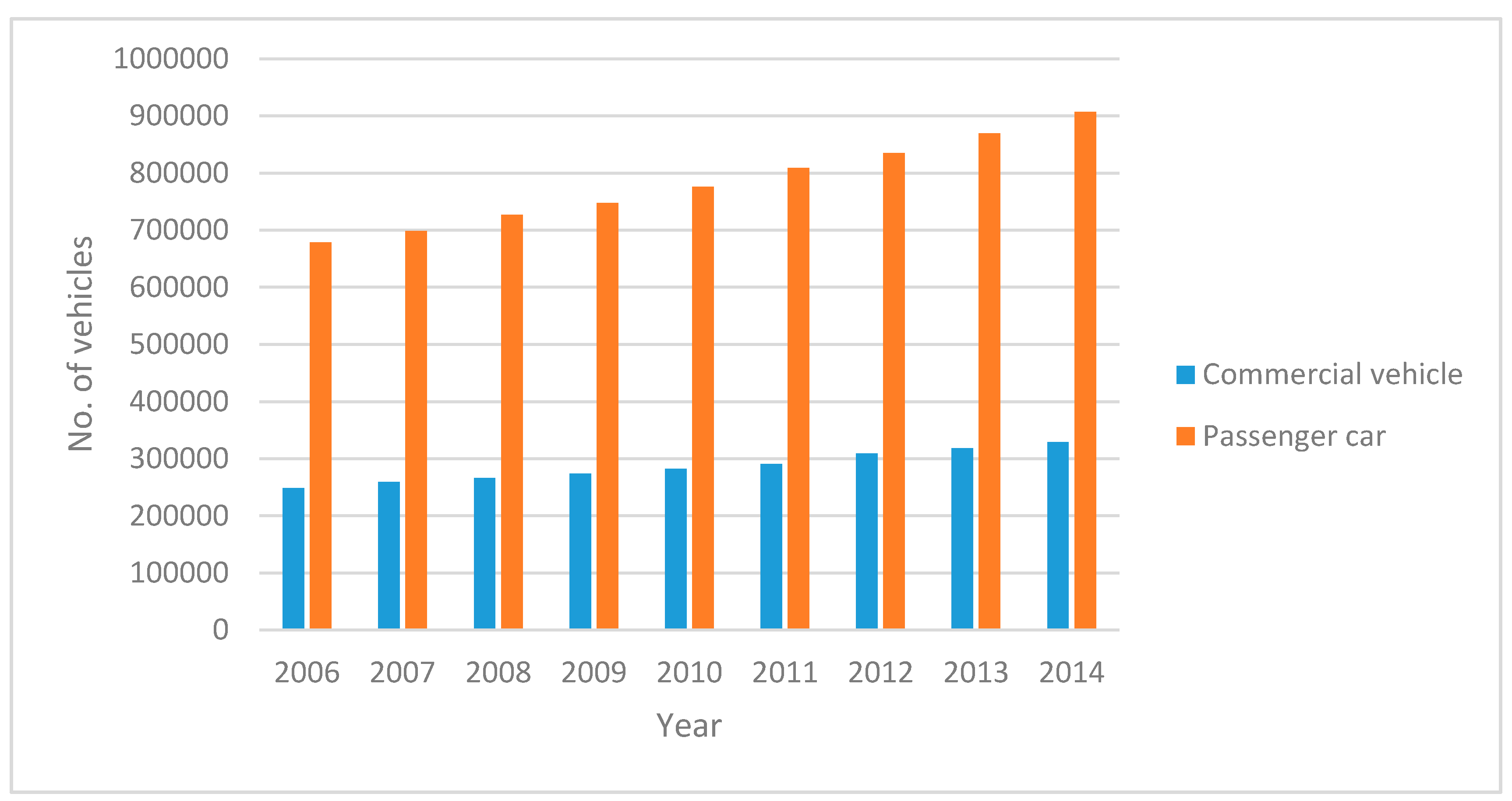
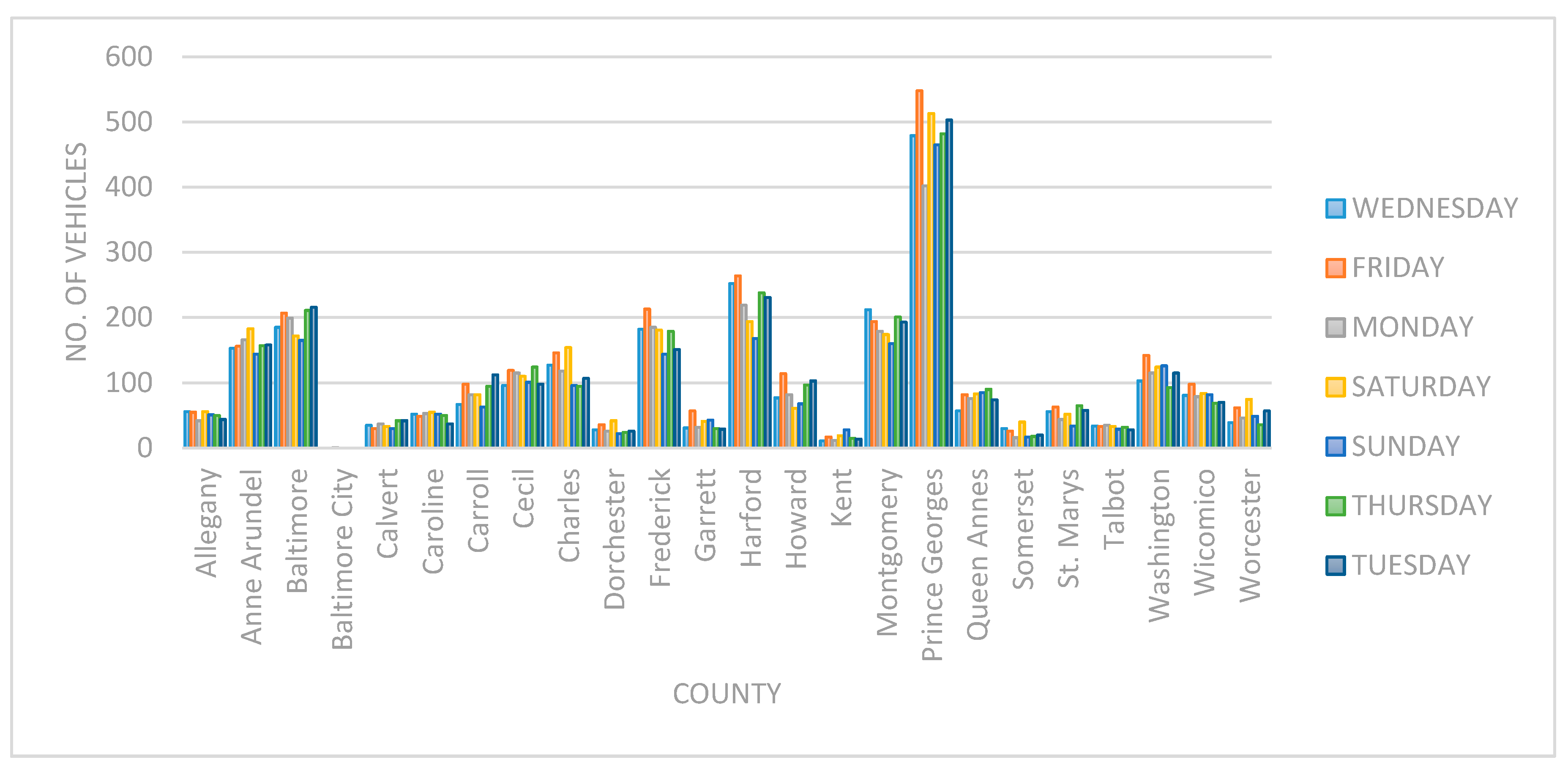
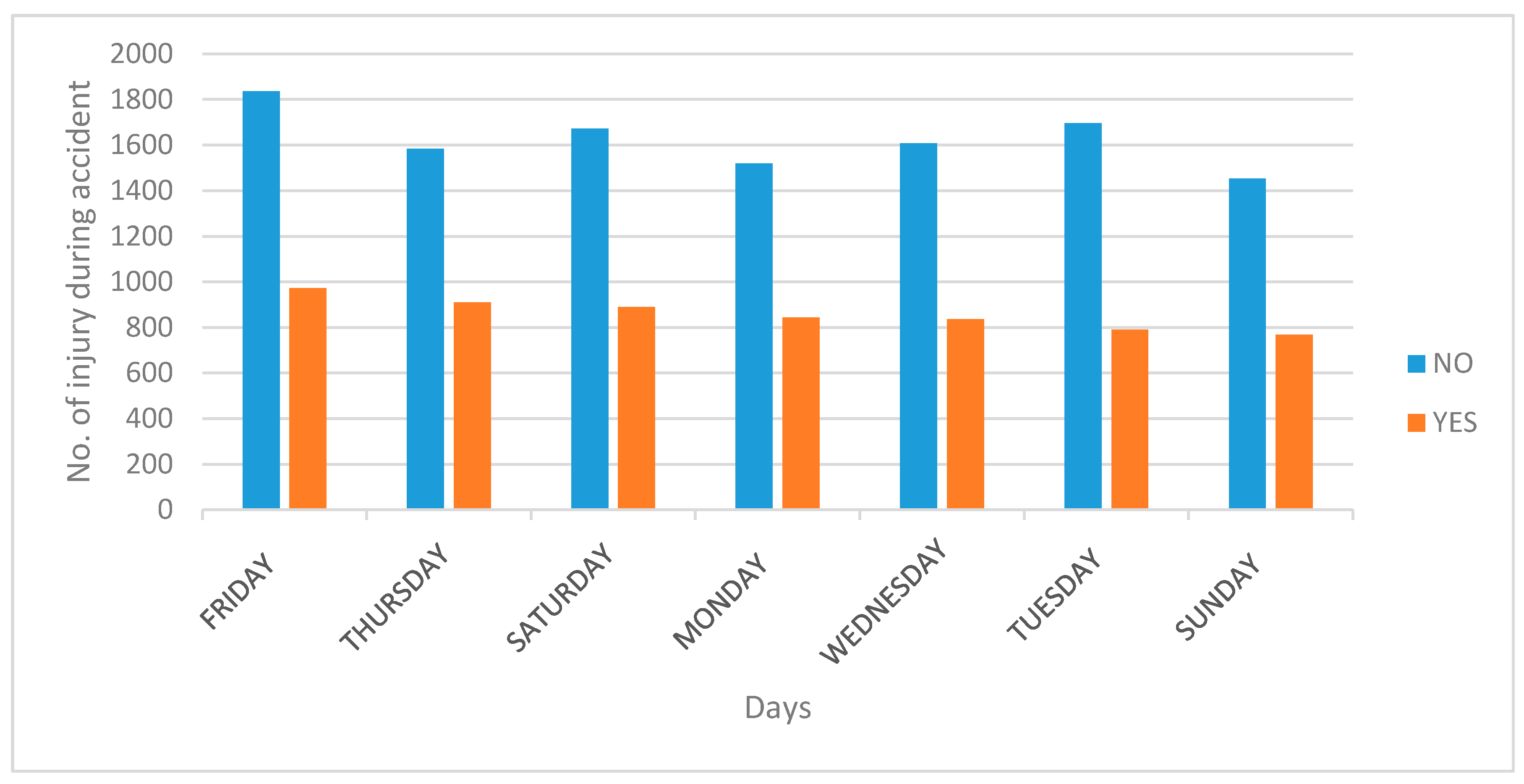
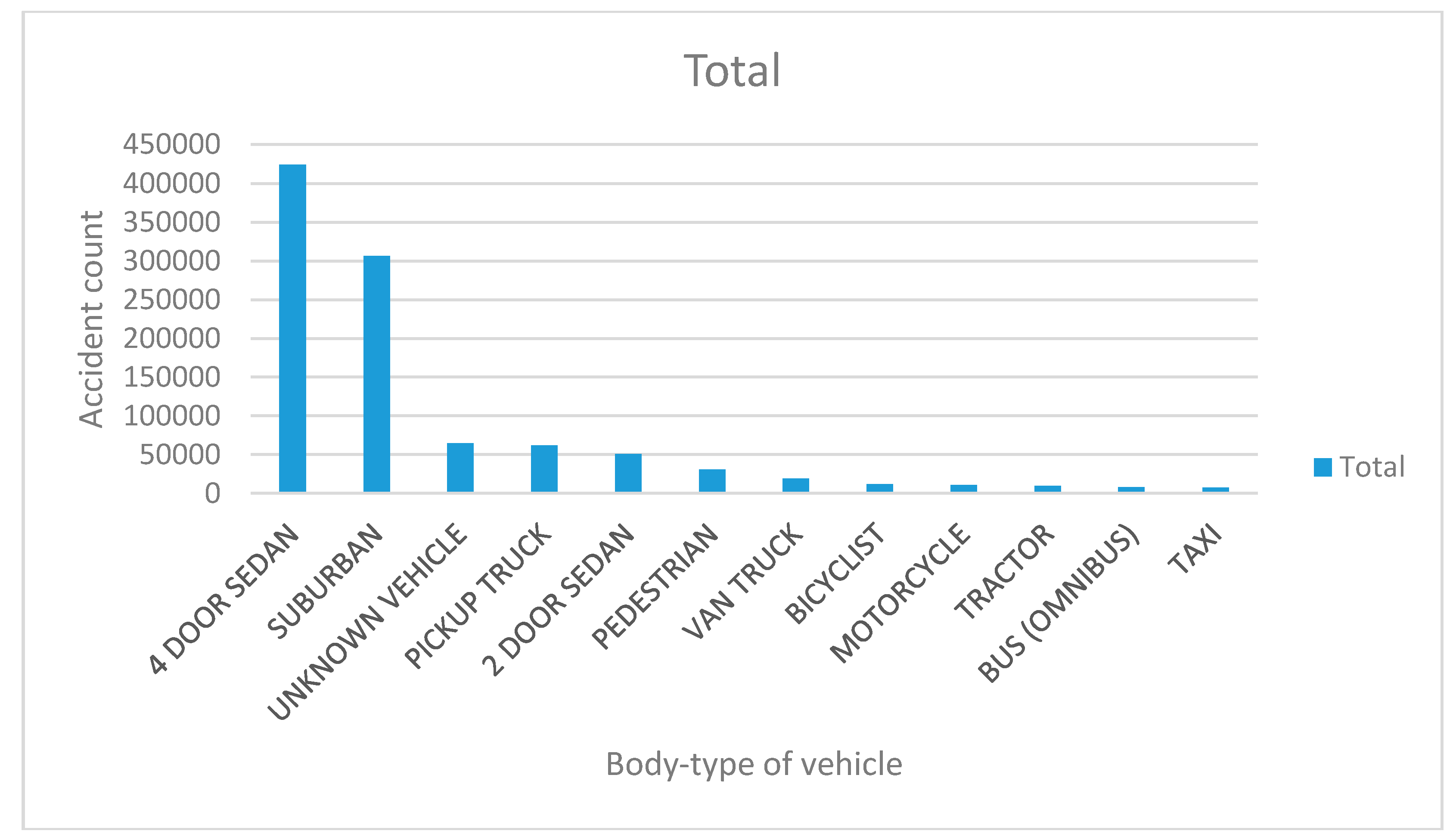
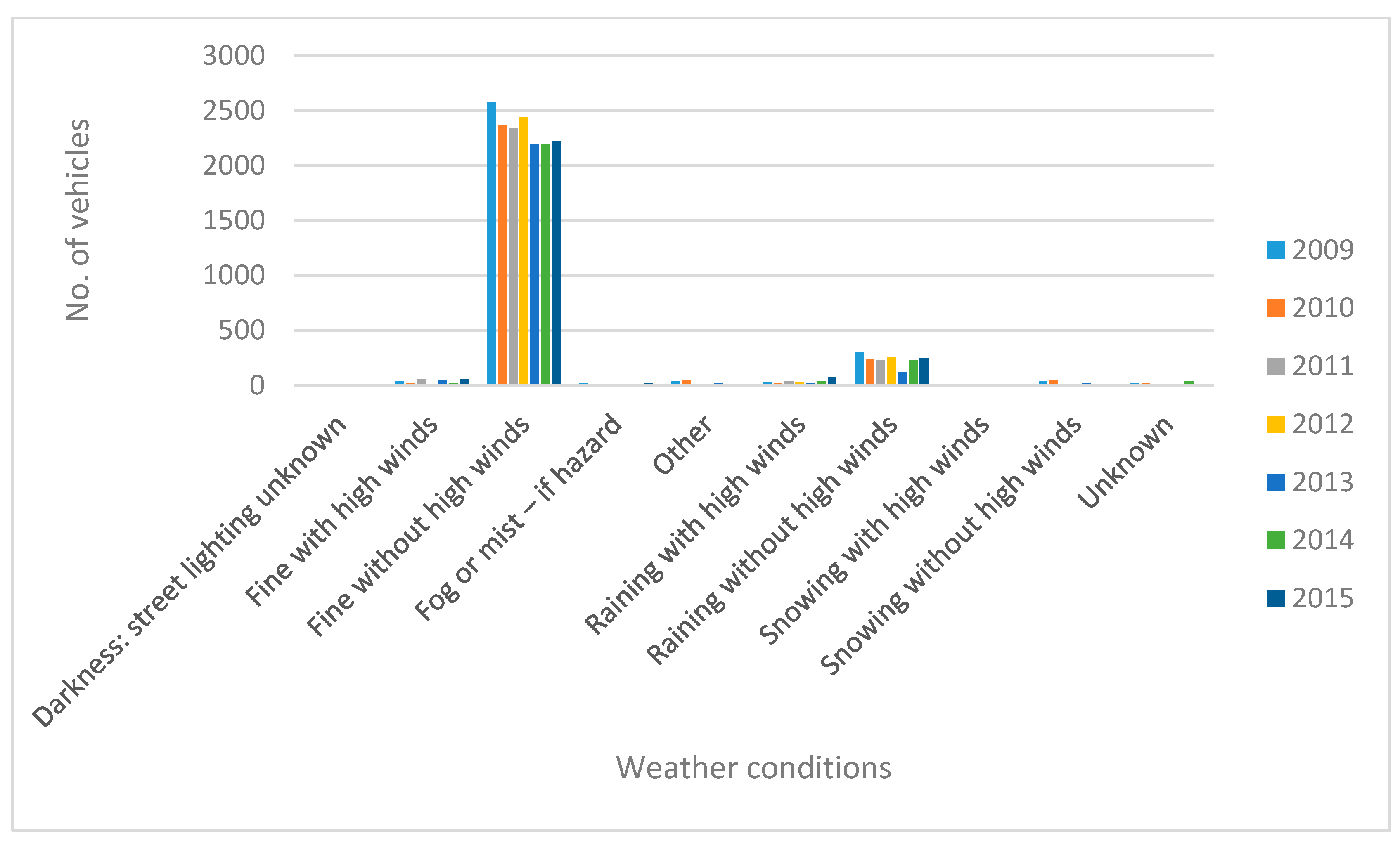
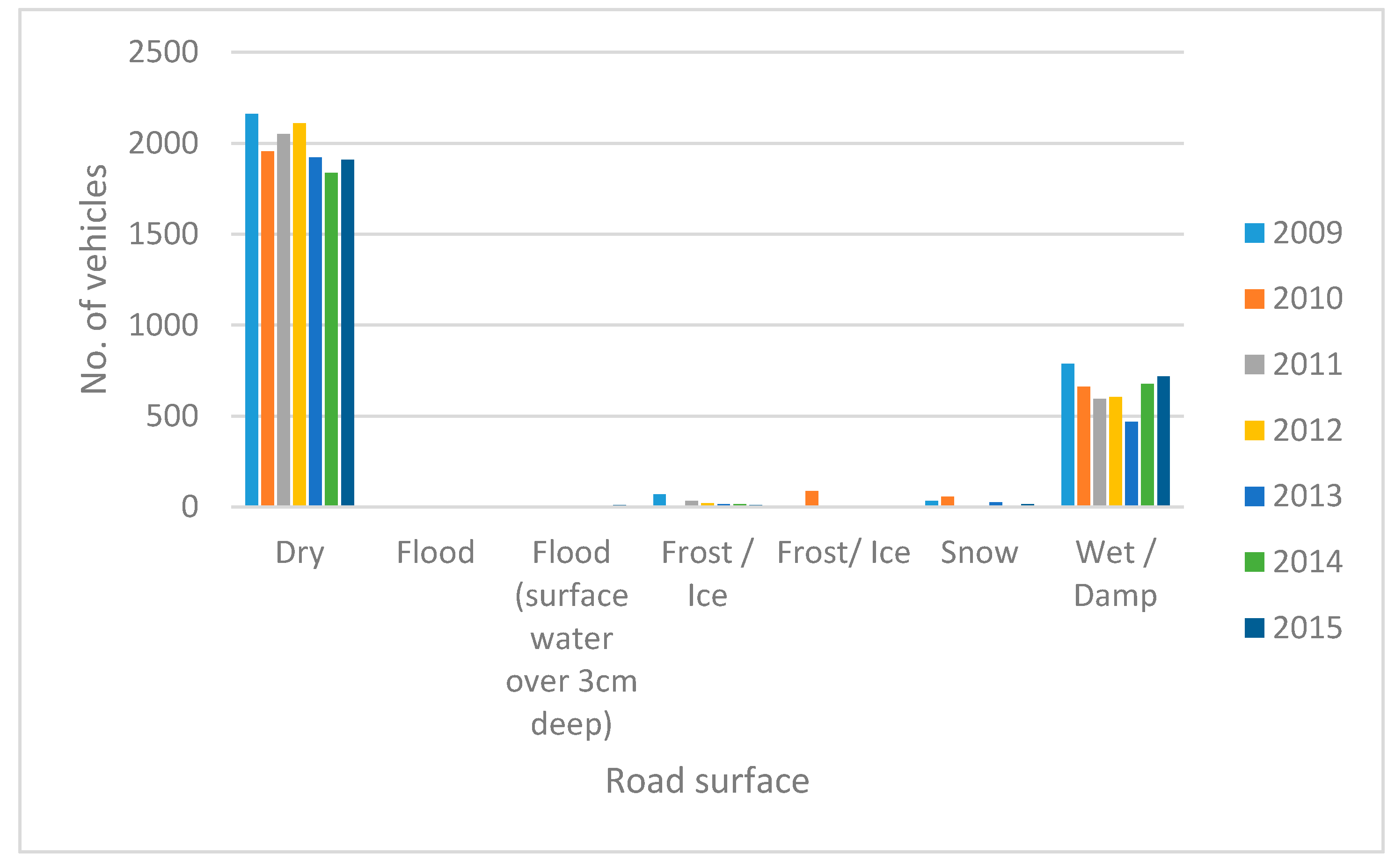
| Sr. No. | Publication | Year | Methodology | Pollution-Free 1 | Carbon Emission Control 1 | Efficient Energy Consumption 1 | Road Traffic Safety 1 | Driver/Passenger Safety 1 |
|---|---|---|---|---|---|---|---|---|
| 1 | [9] | 2009 | Green Transportation | √ | √ | √ | × | × |
| 2 | [10] | 2015 | Green Transportation | √ | √ | √ | × | × |
| 3 | [11] | 2015 | Green Transportation | √ | √ | √ | × | × |
| 4 | [12] | 2016 | Green Transportation | √ | × | × | × | × |
| 5 | [13] | 2016 | Green Transportation | √ | √ | √ | Weak focus | Weak focus |
| 6 | [14] | 2005 | Collision Avoidance | × | × | × | √ | √ |
| 7 | [15] | 2011 | Collision Avoidance | × | × | × | √ | √ |
| 8 | [16] | 2014 | Collison Avoidance | × | × | × | √ | √ |
| 9 | [17] | 2016 | Collision Avoidance | × | × | × | √ | √ |
| 10 | [18] | 2016 | Collision Avoidance | Weak focus | × | Weak focus | √ | √ |
| 11 | [26] | 2014 | Electric Vehicle | √ | √ | √ | × | × |
| 12 | [27] | 2016 | Electric Vehicle | √ | Weak focus | × | √ | × |
| 13 | [28] | 2016 | Electric Vehicle | √ | √ | √ | × | × |
| 14 | [30] | 2015 | Autonomous Vehicle | √ | × | × | Weak focus | × |
| 15 | [31] | 2016 | Autonomous Vehicle | √ | × | × | Weak focus | × |
| 16 | [32] | 2016 | Autonomous Vehicle | √ | × | × | Weak focus | × |
| 17 | [33] | 2016 | Autonomous Vehicle | √ | Weak focus | Weak focus | Weak focus | Weak focus |
© 2017 by the authors. Licensee MDPI, Basel, Switzerland. This article is an open access article distributed under the terms and conditions of the Creative Commons Attribution (CC BY) license (http://creativecommons.org/licenses/by/4.0/).
Share and Cite
Balasubramaniam, A.; Paul, A.; Hong, W.-H.; Seo, H.; Kim, J.H. Comparative Analysis of Intelligent Transportation Systems for Sustainable Environment in Smart Cities. Sustainability 2017, 9, 1120. https://doi.org/10.3390/su9071120
Balasubramaniam A, Paul A, Hong W-H, Seo H, Kim JH. Comparative Analysis of Intelligent Transportation Systems for Sustainable Environment in Smart Cities. Sustainability. 2017; 9(7):1120. https://doi.org/10.3390/su9071120
Chicago/Turabian StyleBalasubramaniam, Anandkumar, Anand Paul, Won-Hwa Hong, HyunCheol Seo, and Jeong Hong Kim. 2017. "Comparative Analysis of Intelligent Transportation Systems for Sustainable Environment in Smart Cities" Sustainability 9, no. 7: 1120. https://doi.org/10.3390/su9071120





